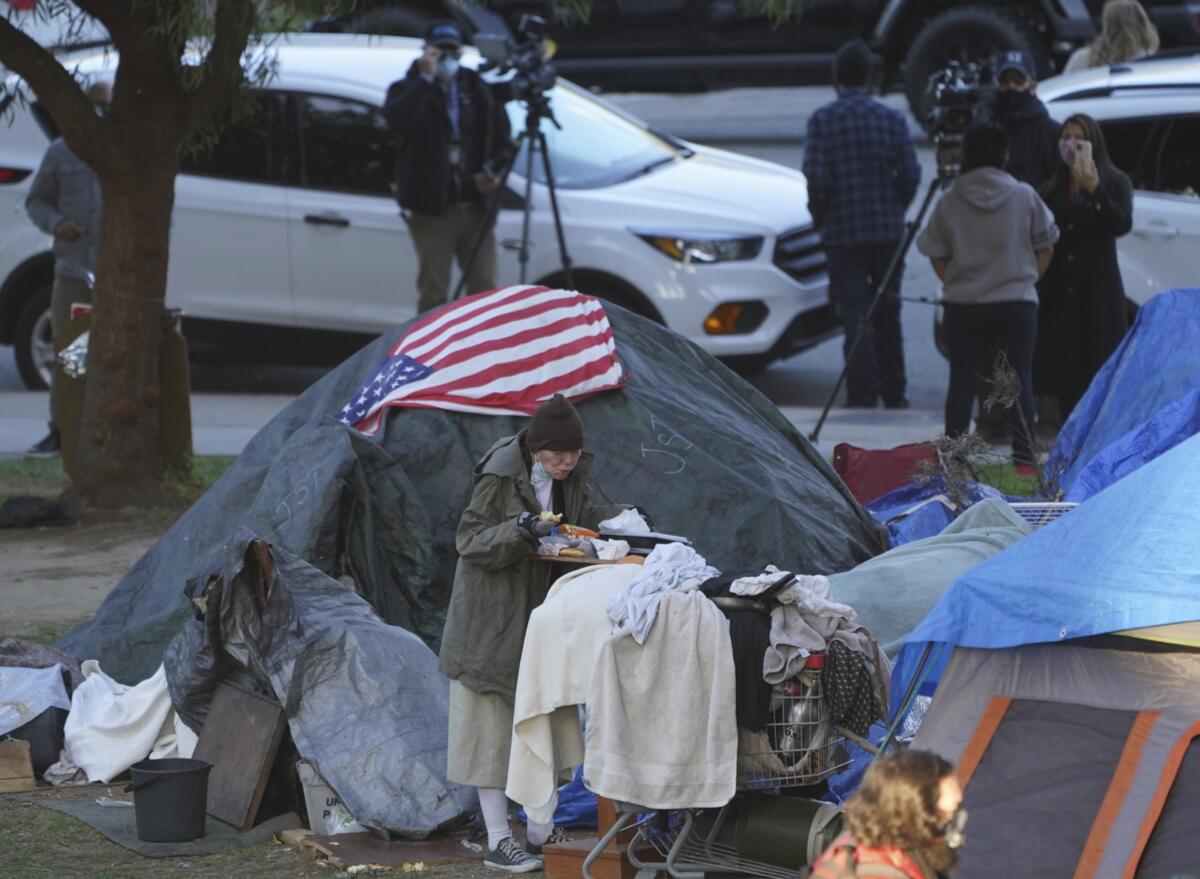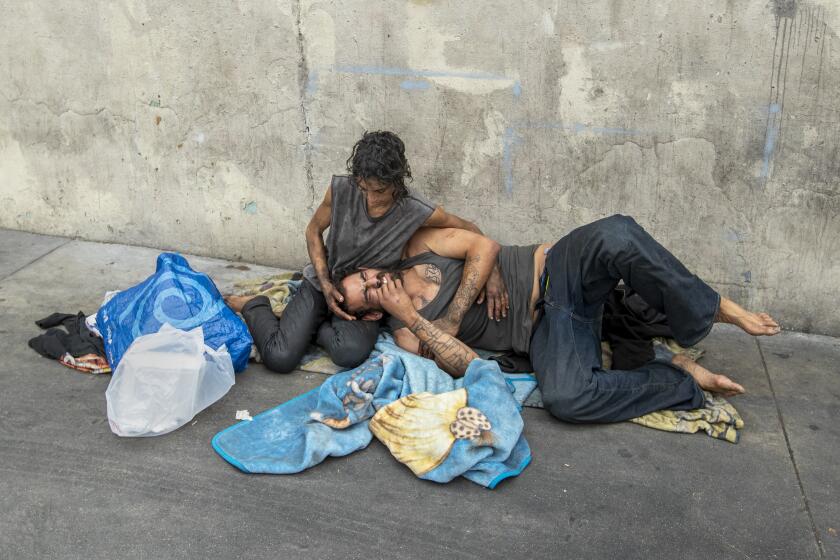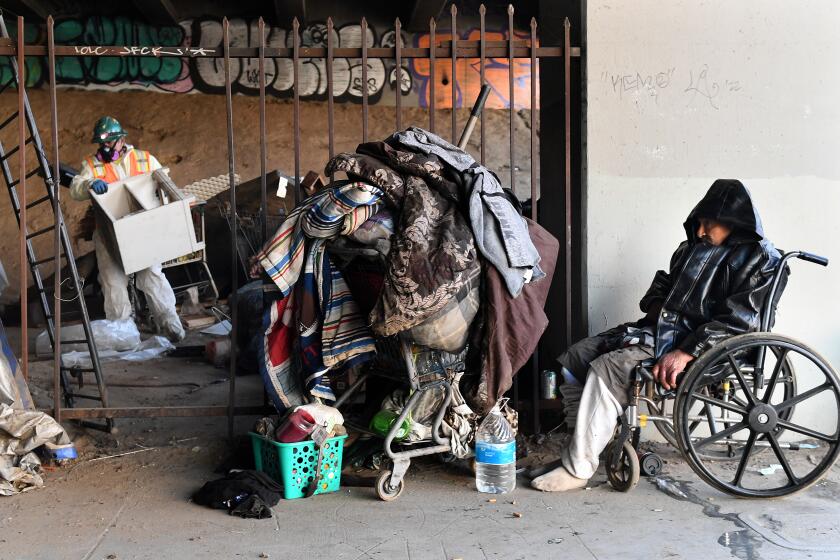What we know about Newsom’s plan to compel care for homeless, mentally ill Californians

Mayors of some of California’s largest cities on Friday endorsed Gov. Gavin Newsom’s proposal to push more people with severe mental health and addiction issues into court-ordered treatment, or at least a framework of the idea.
So far, Newsom has unveiled general details of his plan, which he’s calling the Community Assistance, Recovery and Empowerment Court. The goal of CARE Court is to leverage judicial power to compel thousands of people struggling with serious addiction, mental and behavioral health issues and chronic homelessness into treatment and housing.
The bipartisan group of mayors expressed hope, however vague, that the plan could finally get their most desperate residents into much-needed treatment. Los Angeles Mayor Eric Garcetti said he wanted to “wholeheartedly embrace” the CARE Court framework. Sacramento Mayor Darrell Steinberg said he was “very, very pleased” about what he characterized as a “fundamental shift in the law.”
Others hinted at the need for more details and referred to the proposal as just one of many needed to solve the crisis.
Gov. Gavin Newsom’s administration unveiled a plan to expand access to mental health care. It’s the opening play in an overdue discussion.
“Many details of the proposal before us need to be discussed by stakeholders and service providers,” Bakersfield Mayor Karen Goh said. “But we agree that we must find more effective solutions to mental health care and treatment for our homeless residents. This plan of care, this plan of housing and the court-ordered response, is a step.”
Here is what we know so far about CARE Court, and what we don’t.
What CARE Court does
Each of California’s 58 counties would set up the programs as part of their civil court systems. Family members, clinicians, counties, behavioral health providers and first responders could all petition a judge to implement plans for people in need.
Program participants do not have to be homeless. The CARE Court framework specifically aims to reach those who suffer from untreated psychotic disorders such as schizophrenia and individuals with substance abuse disorders. They could include those who were just arrested and released, or those who are exiting a short-term involuntary hospital hold.
Judges would have to order a clinical assessment, and eligible participants would be placed under court-ordered care for up to 24 months. The program emphasizes medication, housing and substance abuse treatment.
“We’re putting everything we can into this,” Newsom said. “We recognize what you see every single day. It’s unacceptable. And we recognize our responsibility, our moral responsibility.”
CARE Court is not conservatorship reform
In January, Newsom suggested “leaning into conservatorships” this year. Instead, he went with CARE Court.
It’s unclear why the governor pivoted, but conservatorships are considered highly controversial. Critics depict them as an inhumane mechanism to strip individuals of their rights, while proponents herald them as a way to help those who cannot help themselves.
CARE Court would instead emphasize partnership with a participant via a “client-centered approach” to treatment. The plans would be managed by a community care team.
Generally, Latinos are concerned about crime and racial discrimination but not on board with defunding the police, according to the survey.
‘“We’re here about supportive decision-making, coming in, working with stabilizing individuals to the point where that insight, that judgment that’s missing to make important clinical medical decisions, begins to get restored,” said Dr. Mark Ghaly, California’s health and human services secretary.
Participants could still be hospitalized or ordered into a conservatorship if a CARE Court plan is unsuccessful, though it is unclear what criteria would be used to make that decision.
How much will CARE Court cost?
That’s also unknown. But the new program would probably require a blend of existing and new funding, and what Newsom described as “unprecedented investments” in setting up the necessary clinical infrastructure and workforce.
Billions are already on the table from recent investments for mental and behavioral health services, along with supportive housing. But new dollars would be needed to support the courts’ implementation of the programs and to finance the public defenders and so-called supporters who would accompany a court-ordered treatment plan.
The administration said it still needs to work with the Legislature and Judicial Council to crunch the numbers and determine how much this new plan would cost.
When will CARE Court go into effect?
Again, that is unclear. Newsom pledged urgency in enacting CARE Court, but the plan still requires legislative approval.
Newsom said he thinks the CARE Court framework belongs in the budget, which would allow for quicker implementation because lawmakers need to approve the fiscal blueprint each year in June. Until then, the administration has to negotiate with stakeholders and legislative leaders.
“It’s going to be stubborn. We’ve got work to do,” Newsom said. “We’ve got to get [it] approved by the Legislature. We want to move this in the next couple of months.”
More to Read
Sign up for Essential California
The most important California stories and recommendations in your inbox every morning.
You may occasionally receive promotional content from the Los Angeles Times.













